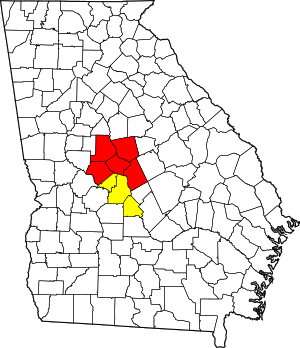Jeffersonville, Georgia
The city of Jeffersonville is the largest city and county seat of Twiggs County, Georgia, United States.[5] The population was 1,035 at the 2010 census, down from 1,209 in 2000.
Jeffersonville, Georgia | |
|---|---|
 Twiggs County Courthouse (built 1903), Jeffersonville, Georgia | |
 Location in Twiggs County and the state of Georgia | |
| Coordinates: 32°41′2″N 83°20′23″W | |
| Country | United States |
| State | Georgia |
| County | Twiggs |
| Area | |
| • Total | 3.67 sq mi (9.50 km2) |
| • Land | 3.65 sq mi (9.47 km2) |
| • Water | 0.01 sq mi (0.03 km2) |
| Elevation | 518 ft (158 m) |
| Population (2010) | |
| • Total | 1,035 |
| • Estimate (2019)[2] | 939 |
| • Density | 256.91/sq mi (99.18/km2) |
| Time zone | UTC-5 (Eastern (EST)) |
| • Summer (DST) | UTC-4 (EDT) |
| ZIP code | 31044 |
| Area code(s) | 478 |
| FIPS code | 13-42100[3] |
| GNIS feature ID | 0356333[4] |
| Website | cityofjeffersonville |
Jeffersonville is part of the Macon Metropolitan Statistical Area.
History
The city was named after the Jefferson family of settlers.[6] Jeffersonville was named county seat in 1868, when the seat was transferred from Marion.[7]
Geography
Jeffersonville is located at 32°41′2″N 83°20′23″W (32.683982, -83.339683).[8]
The city is located in the central part of the state, very close to the geographic center of the state. Interstate 16 runs northwest to southeast just south of the city, leading southeast 148 mi (238 km) to Savannah and northwest 25 mi (40 km) to Macon. U.S. Route 80 travels through the city, as well as state routes 18 and 96.
According to the United States Census Bureau, the city has a total area of 3.7 square miles (9.6 km2), all land.
Demographics
| Historical population | |||
|---|---|---|---|
| Census | Pop. | %± | |
| 1880 | 156 | — | |
| 1910 | 740 | — | |
| 1920 | 842 | 13.8% | |
| 1930 | 692 | −17.8% | |
| 1940 | 804 | 16.2% | |
| 1950 | 787 | −2.1% | |
| 1960 | 1,013 | 28.7% | |
| 1970 | 1,302 | 28.5% | |
| 1980 | 1,473 | 13.1% | |
| 1990 | 1,545 | 4.9% | |
| 2000 | 1,209 | −21.7% | |
| 2010 | 1,035 | −14.4% | |
| Est. 2019 | 939 | [2] | −9.3% |
| U.S. Decennial Census[9] | |||
As of the census[3] of 2000, there were 1,209 people, 436 households, and 320 families residing in the city. The population density was 328.8 people per square mile (126.8/km2). There were 496 housing units at an average density of 134.9 per square mile (52.0/km2). The racial makeup of the city was 36.72% White, 62.37% African American, 0.25% Native American, 0.17% Asian, 0.08% from other races, and 0.41% from two or more races. Hispanic or Latino of any race were 2.73% of the population.
There were 436 households, out of which 28.2% had children under the age of 18 living with them, 45.2% were married couples living together, 23.9% had a female householder with no husband present, and 26.6% were non-families. 23.9% of all households were made up of individuals, and 9.6% had someone living alone who was 65 years of age or older. The average household size was 2.67 and the average family size was 3.18.
In the city, the population was spread out, with 25.0% under the age of 18, 10.1% from 18 to 24, 28.8% from 25 to 44, 23.9% from 45 to 64, and 12.2% who were 65 years of age or older. The median age was 36 years. For every 100 females, there were 85.1 males. For every 100 females age 18 and over, there were 82.1 males.
The median income for a household in the city was $25,000, and the median income for a family was $37,500. Males had a median income of $29,722 versus $21,042 for females. The per capita income for the city was $13,021. About 17.4% of families and 21.4% of the population were below the poverty line, including 30.9% of those under age 18 and 21.2% of those age 65 or over.
Education
Twiggs County School District
The Twiggs County School District holds pre-school to grade twelve, and consists of four elementary schools (two include pre-school programs), a middle school and a high school.[10] The district has 100 full-time teachers and over 1,489 students.[11]
- Jeffersonville Elementary
- Twiggs Middle School
- Twiggs County High School
Private education
References
- "2019 U.S. Gazetteer Files". United States Census Bureau. Retrieved July 9, 2020.
- "Population and Housing Unit Estimates". United States Census Bureau. May 24, 2020. Retrieved May 27, 2020.
- "U.S. Census website". United States Census Bureau. Retrieved 2008-01-31.
- "US Board on Geographic Names". United States Geological Survey. 2007-10-25. Retrieved 2008-01-31.
- "Find a County". National Association of Counties. Archived from the original on 2011-05-31. Retrieved 2011-06-07.
- Hellmann, Paul T. (May 13, 2013). Historical Gazetteer of the United States. Routledge. p. 234. Retrieved 30 November 2013.
- Krakow, Kenneth K. (1975). Georgia Place-Names: Their History and Origins (PDF). Macon, GA: Winship Press. p. 120. ISBN 0-915430-00-2.
- "US Gazetteer files: 2010, 2000, and 1990". United States Census Bureau. 2011-02-12. Retrieved 2011-04-23.
- "Census of Population and Housing". Census.gov. Retrieved June 4, 2015.
- Georgia Board of Education, Retrieved June 29, 2010.
- School Stats, Retrieved June 29, 2010.

